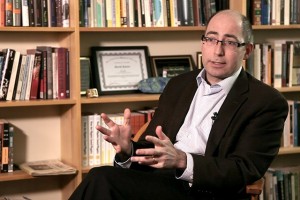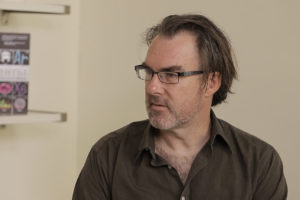Higher Education and Employability
David Dussault on the ideal type of students, gig economy and the difference between skills and knowledge
One of the things that I’m interested in doing in my research is looking at socialist urbanism and also post-socialist urbanism, or what you could call still socialist urbanism by means of ideas, which are not only ideas imported from Western critical theory or from Western urban theory, not only looking at the socialist city through the lens of Foucaultean biopolitics or through the lens of American anthropologists ideas about new liberalism or through the lens of Jacques Rancière aesthetic philosophy or whatever, but also trying to look at socialist cities and socialist culture and also post-socialist culture or still socialist culture through the lens of ideas that are somehow taken from the socialist city and from socialist culture itself.
In anthropology there’s a distinction that anthropologists have always made on and off I suppose between emic and etic ideas, between an emic or an etic anthropological analysis. An etic anthropological analysis is one, which takes an idea derived from the ethnographers’ arsenal of theory, an idea from elsewhere, and applies it to the anthropological setting, to the ethnographic field site. Whereas an emic idea is an idea that’s taken from that fueled set itself, and then is deployed or is used to try to understand that place.
It’s very tempting, if you’ve just come out of a PhD and you’ve been bombarded with with Foucault and with Rancière or especially Bruno Latour or Gilles Deleuze, to see everything through the lens of rhizomes and blah-blah-blah. Sometimes it’s much more interesting and more productive, and produces more useful analysis to try to take some ideas from the place, by which you are studying, and to try to make a genuine effort to understand them, and then to apply them not only in your discussions with your informants, but also in your analysis, also in the way that you write up two findings of your fieldwork.
Socialist urbanism is a particularly rich field to use this agricultural metaphor that anthropologists are fond of using for these kinds of ideas partly and as socialist culture in general. For the perfectly obvious reason that socialist culture was produced, was made by theorists, who were schooled in Marxist theory or in various kind of interpretations of Marxist theory, and who applied that Marxist to the very process of building socialism and to the process of building the socialist city.
The history of the socialist city, but also the story of its unraveling is very much a story in which the line between the theory and the practice of Marxism becomes blurred. Here you have a theory, which is being employed by people who are more or less theoretically trained in order to actually produce a social life, in order to engineer a social life and in order to envision and then to actually put into practice in an urban environment.
You have another way of talking about this is not necessary through the language of emic versus etic ideas, but also through the language of the idea of the vernacular, of a kind of language, which was spoken by the people, which you study, and which it is your job as a scholar to analyze.
The interesting thing in about Marxism-Leninism itself is that Marxism and Leninism is a Russian vernacular, which was formulated at the end of the 19th century, the beginning of the 20th century in order to translate canonical Marxist texts to foment a revolutionary situation in Russia, and to render them applicable in the context of the former Russian Empire. In the context of the socialist city you have further branchings out of vernacular, you have kind of urbanist sub-vernaculars of Marxism, which are employed by Marxist theorist of the city, by socialist urbanists who hadn’t necessarily read that much of Marx, who have read some Marx, but not necessary read that much Lenin either, who nevertheless considered themselves Marxist, or who for conjuncture reasons or for genuinely ideological reasons employed these Marxist ideas and used them to construct the socialist city.
If we’re talking about this emic or vernacular Marxism, there’s an example of an article published in 2017 by an Anna Kruglova, who is an anthropologist based at the Higher School of Economics in Moscow, in which she traces the way in which her informants in the city of Perm in Siberia employ a particular forms of vernacular Marxism simply in their everyday conversations. You can use a similar approach to figuring out how people employ some sort of vernacular, which is connected to Marxism in various ways, in the context of the professional practice of building the socialist city. You can look through text and also talk to various architects who are working in Moscow or Warsaw today, especially the more established generation of architects and urbanists, and planners, still are from the generation where they had to be relatively fluent in a kind of Marxist urban vernacular in order to work.
You can still trace how this Marxist urban vernacular continues to exist in the way that they theorize and they think about a city, which they in many cases as architects now working for capitalist developers, who are in the process of deconstructing the very city which they themselves have built. In any case the work of these urban theorists and of these architects is full of interesting and very rich vernacular ideas, which can really enrich and inform the way in which we think about socialist cities.
One example of these ideas, which I’m particularly interested in, is the idea of the ‘social condenser’. This is an idea, which is 90 years old. It was formulated in 1927 by the Soviet constructivists, by people like Moisei Ginzburg and Ivan Leonidov, and others. It was an idea, which was formulated actually in 1927 on the 10th anniversary of the October Revolution as a “социальный конденсатор” in Russian. Condenser previously in English was a word which referred to an electrical transformer, which used to be called in English an electrical condenser, so a machine for changing the either intensifying or deintensifying the way a current flows through an electrical circuit.
In the context of the 1920s, in the context of time that was fascinated with electricity, fascinated with electrification, everyone knew Lenin’s famous quote that communism equals Soviet power plus the electrification of the entire country. This fascination of the power of electricity was taken on as a metaphor by Ginzburg, by Leonidov, by the by the constructivists who belong to the Organization of Contemporary Architects, which grouped together the architectural constructivist. They took this term and they used it as a general term formulated for the 10th anniversary of the October Revolution to define what it was that distinguished the architecture of the post-revolutionary era from the architecture of the pre-revolutionary era.
As the editorials of Sovremennaya Architektura (Contemporary Architecture) and also the text of Ginzburg and Leonidov published in Contemporary architecture and, which was the main mouthpiece of the constructivists, constantly repeated the idea of the social condenser. This was the very idea, which would distinguish the avant-garde modernism of the post-October period from the avant-garde modernism, which was practiced in capitalist countries, which was practiced in the West, and also from the modern architecture, which existed in Russia before the Revolution.
So the social condenser was a term, which was a sort of metaphor, which could be applied to architecture at all scales: it could be applied to residential architecture, it could be applied to public buildings, it could be applied to public space and also to the planning of the city as a whole. It was very much a metaphor for thinking about how you could design this ideological intensity into the city, to forge a kind of collectivity and to become and to become communists.
It was a very powerful idea, which existed for a very brief period of time. It was only used by the constructivists, it was used very frequently on the pages of Contemporary architecture, of Sovremennaya Architektura (Современная Архитектура) during 1927 and 1928. Then it suddenly disappeared from regular usage and fizzled out. The social condense as such was basically forgotten about.
The idea of the “microrayon” is an idea that is mostly associated with the Khrushchev era and with the Brezhnev era, with 60s and 70s Soviet town planning. It refers to a kind of multifunctional residential unit, which is planned and made normally of prefabricated buildings, but which consists not only of residential buildings themselves, but also of district clubs, of sports facilities, of leisure facilities, of commercial facilities, etc. So, it is very much a sort of self-sustained unit, in which people could live their lives in an initiative rich variety of ways.
In my work on the Palace of Culture in Warsaw, which is a sort of multifunctional skyscraper built during the Stalin era, but still existing today, I present the Palace of Culture as a type of social condenser. Jane Rendell talks about the social housing of London, which is being demolished or which is being subjected to devastating prettification as a type of social condenser, which is being lost. You can also think in a similar way about the social housing of the of the Khrushchev era in in Moscow.
The Khrushchevki were already demolished during the Luzhkov era, during the first 20 years of the post-soviet Moscow. There is a grand new scheme that the current Moscow city government is pursuing of demolishing over five thousand Khrushchev era buildings and replacing them in all probability with sort of cheaply built developer enriching housing. It’s possible to present, I think, in a certain way the Khrushchevki, the housing program of the post-war Soviet Union was notable not only for its scale, not only for its vast reach, not only for the pure number, not only for the vast number of people it was able to house in a short period of time, but also – as scholars like the historian Mark Smith and Steve Harris have pointed out – it’s also notable for the extent, to which it mixes different social groups within these buildings.
There was a very carefully and consciously articulated practice not only in the Soviet Union, but in other Eastern European countries too, and also to some extent in the welfare states of Western Europe, North America, South America and elsewhere, of social mixing within the social housing that was built in the post-war era.
You could say that the Khrushchev era housing of the 1960s and then later the Brezhnev era housing of the 1970s was one of the most triumphant examples of social mixing, of the transformation of a social fabric through mixing different kinds of categories, mixing ‘intelligentsia’, working-class people, actors, doctors and as many different layers of societies as they possibly could in one place, in particular housing blocks. It’s this it’s this social condenser, which perhaps could be represented as the greatest social condenser of all time, because in its scope and because of different amount of people that were mixed through this housing, which is arguably being dismantled today through these kinds of programs, which are mostly designed to benefit developers and private interests, rather than those of the city itself and of the people who inhabit it.

David Dussault on the ideal type of students, gig economy and the difference between skills and knowledge

Physicist David Kaiser on the US education funding course, the impact of politics on physics, and connections ...

Art historian Jeffrey Taylor on the art market, the ‘American Leonardo’ and why connoisseurship doesn't work i...